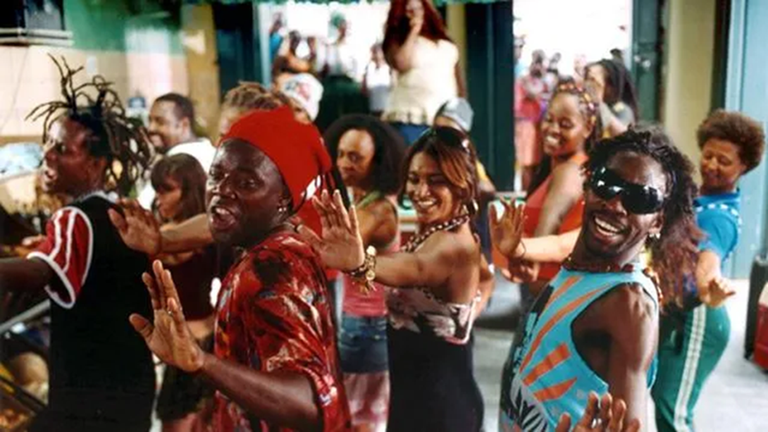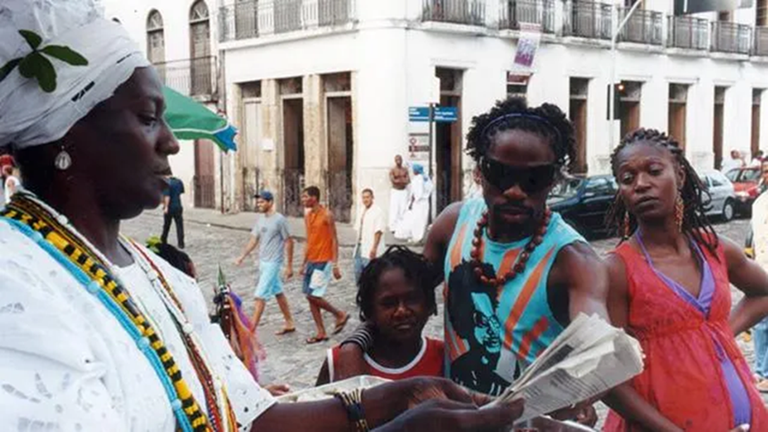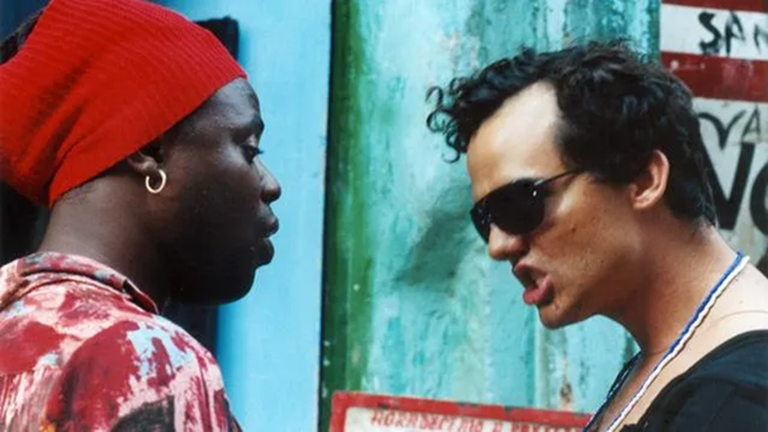[PT-BR/EN] CRÍTICA DE FILME: “Ó Pái, Ó” (2007)
 IMDb
IMDb[PT-BR]
Sinopse: A paixão coletiva pelo Carnaval une os pitorescos moradores de um animado cortiço que fica localizado no Pelourinho, o centro histórico mais famoso de Salvador (região Nordeste do Brasil). No entanto, para conseguirem viver essa festa, eles precisam enfrentar Dona Joana, que é uma síndica com valores altamente religiosos.
Em um retrato soteropolitano que por muitas vezes é demasiadamente exagerado na sua apresentação (e também em praticamente todo o seu desenvolvimento), este filme traz as raízes da Bahia dentro de um roteiro repleto de caricatura social que abraça também aspectos políticos e culturais. Usando um dos cenários mais famosos da Bahia (Pelourinho), à trama vai sendo desenvolvida sob diferentes tipos de situações, que juntas acabam criando à forma e o peso de tudo. Envolvendo religião, política e cultura de uma maneira relativamente peculiar, essa comédia é algo bastante perspicaz.
 Globo Filmes
Globo FilmesA ideia central do projeto é excelente, porque consegue criar um “produto regionalista” fiel às suas raízes (mesmo com todos os seus exageros propositais) e que oportuniza um conhecimento mais profundo sobre à cultura desse povo em suas mais diferentes situações, que aliás, são vivenciadas cotidianamente. Literalmente, é quase como estar na Bahia sem estar de fato nela. Basicamente, esse feito é atingindo pelo mergulho comportamental e cultural que o filme traz, e o melhor de tudo é que essa qualidade acaba aparecendo na tela sem haja um esforço estratégico para isso acontecer.
Há um desfile de personagens cômicos (liderados pelos atores Lázaros Ramos e Wagner Moura, que aqui entregam as suas melhores performances dentro de um filme de comédia, que ao mesmo tempo consegue trazer aspectos regados com toques sensíveis de drama) que abraça a realidade que está sendo contada, e em momentos específicos, cada um deles encontra seu momento único de brilhar (mesmo que não sejam desenvolvidos de uma maneira mais satisfatória). Até mesmo os personagens pontuais (como a personagem interpretada por Dira Paes) conseguem o seu “lugar ao sol”.
 Globo Filmes
Globo FilmesPor outro lado, mesmo sendo um projeto bastante eficiente na essência da sua ideia, há alguns aspectos que o tornam em algo bagunçado demais. Um exemplo muito óbvio disso é que o próprio roteiro não tem um pilar norteador, e isso fica muito transparente quando os personagens aparecem e desaparecem das cenas falando alguma piada que não se conecta com o filme por completo. Isso é similar ao que é feito nas séries de televisão... O que não funciona bem aqui, afinal, estamos falando de um longa-metragem, e as estruturas de um produto desses são completamente diferentes.
Muitas piadas são boas, mas algumas são jogadas fora de um contexto e por isso acabam perdendo o seu efeito. O fato de não haver uma “cola” que “gruda” todos os acontecimentos (embora haja uma tentativa de fazer isso usando Dona Joana, que é a síndica do cortiço) faz muita falta dentro do roteiro, porque o que é projetado na tela funciona melhor quando é estrategicamente separado. Nesse aspecto, como filme, há algumas falhas por não fazer a narrativa coexistir e ao optar por uma abordagem muito “desconectada” da sua força motriz, acaba sendo um projeto um pouco “frágil”.
 Globo Filmes
Globo FilmesParticularmente falando, o tom quase “cartunesco” da trama como um todo (em especial sobre cada personagem) me incomoda um pouco porque me lembra um grito desesperado de uma estória que grita para existir de um jeito bastante errado (ainda que funcional e pontual em algumas situações). Ao mesmo tempo, é isso o que acaba trazendo bastante realidade para um filme de comédia que a todo sempre se beneficia dos costumes de um povo mundialmente famoso. Qualquer projeto que consegue se impor desta maneira merece reconhecimento, e com este aqui não é tão diferente.
Monique Gardenberg comandou o projeto. Escrevendo o roteiro (ao lado de Márcio Meirelles) e dirigindo o filme, ela tinha uma boa visão sobre o todo (ao menos no papel), mas na prática, muitos tiros foram perdidos e munições muito importantes acabaram sendo desperdiçadas. O olhar dela sobre a própria trama foi assertivo, mas a execução teve um círculo de problemas viciosos. Falhas narrativas sistemáticas prejudicaram o resultado, que poderia ter sido muito bom, mas ao mesmo tempo, exalta toda sua qualidade técnica ao conseguir explorar bem os seus cenários, e sua fotografia.
 Globo Filmes
Globo FilmesEm meio as aventuras e desventuras de um povo guerreiro e trabalhador, compelidos por uma triste realidade social e financeira extremamente desafiadora, os personagens de Ó Paí, Ó transcendem à região do Nordeste e se assemelham a outros povos através de outros contextos. Sendo assim, aqui temos uma narrativa muito bem caracterizada, e mesmo com falhas pertinentes, ainda consegue entregar um resultado eficiente e que oferece um debate coletivo interessante. No final de tudo, acaba sendo muito mais do que “apenas” outra comédia brasileira por ser baseada em aspectos reais.

[EN]
Synopsis: The collective passion for Carnival unites the picturesque residents of a lively tenement located in Pelourinho, the most famous historic center of Salvador (Northeast region of Brazil). However, to be able to experience this party, they need to face Dona Joana, who is a property manager with highly religious values.
In a portrait of Salvador that is often too exaggerated in its presentation (and also in practically its entire development), this film brings the roots of Bahia within a script full of social caricature that also embraces political and cultural aspects. Using one of the most famous scenarios in Bahia (Pelourinho), the plot is developed under different types of situations, which together end up creating the shape and weight of everything. Involving religion, politics and culture in a relatively peculiar way, this comedy is quite insightful.
The central idea of the project is excellent, because it manages to create a “regionalist product” that is faithful to its roots (even with all its intentional exaggerations) and that provides deeper knowledge about the culture of these people in their most different situations, which, in fact, are experienced daily. Literally, it's almost like being in Bahia without actually being there. Basically, this feat is achieved through the behavioral and cultural immersion that the film brings, and the best of all is that this quality ends up appearing on the screen without there being a strategic effort to make it happen.
There is a parade of comical characters (led by actors Lázaros Ramos and Wagner Moura, who here deliver their best performances within a comedy film, which at the same time manages to bring aspects sprinkled with sensitive touches of drama) that embrace the reality that is being told, and in specific moments, each of them finds their unique moment to shine (even if they are not developed in a more satisfactory way). Even one-off characters (like the character played by Dira Paes) get their “place in the sun”.
On the other hand, even though it is a very efficient project in the essence of its idea, there are some aspects that make it too messy. A very obvious example of this is that the script itself does not have a guiding pillar, and this becomes very transparent when characters appear and disappear from scenes saying some joke that does not connect with the film as a whole. This is similar to what is done in television series... Which doesn't work well here, after all, we are talking about a feature movie, and the structures of such a product are completely different.
Many jokes are good, but some are thrown out of context and therefore end up losing their effect. The fact that there is no “glue” that “sticks” all the events together (although there is an attempt to do this using Dona Joana, who is the tenement manager) is greatly missed within the script, because what is projected on the screen works best when it is strategically separated. In this aspect, as a movie, there are some flaws in not making the narrative coexist and by opting for an approach that is very “disconnected” from its driving force, it ends up being a somewhat “fragile” project.
Particularly speaking, the almost “cartoonish” tone of the plot as a whole (especially regarding each character) bothers me a little because it reminds me of a desperate cry from a story that screams to exist in a very wrong way (although functional and punctual in some situations). At the same time, this is what ends up bringing a lot of reality to a comedy movie that always benefits from the customs of a world-famous people. Any project that manages to impose itself in this way deserves recognition, and this one is not so different.
Monique Gardenberg led the project. Writing the script (alongside Márcio Meirelles) and directing the movie, she had a good vision of the whole (at least on paper), but in practice, many shots were missed and very important ammunition ended up being wasted. Her look at the plot itself was assertive, but the execution had a circle of vicious problems. Systematic narrative flaws harmed the result, which could have been very good, but at the same time, it highlights all its technical quality by managing to explore its settings and photography well.
Amid the adventures and misadventures of a warrior and hard-working people, compelled by a sad, extremely challenging social and financial reality, the characters of Oh My God! transcend the Northeast region and resemble other peoples in other contexts. Therefore, here we have a very well characterized narrative, and even with pertinent flaws, it still manages to deliver an efficient result that offers an interesting collective debate. At the end of it all, it ends up being much more than “just” another Brazilian comedy as it is based on real aspects.

Posted Using InLeo Alpha

Obrigado por promover a comunidade Hive-BR em suas postagens.
Vamos seguir fortalecendo a Hive